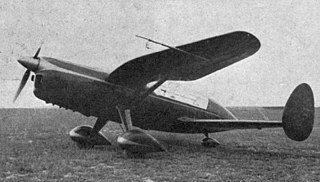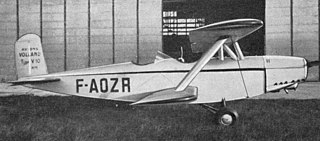Related Research Articles

The Koolhoven F.K.42 was a parasol-wing, two-seat training monoplane manufactured by Koolhoven in the Netherlands. Only one was built.

The Pander E was the first indigenous Dutch training aircraft, used by clubs and also privately owned. A two-seat, single-engine biplane, 17 were built in the Netherlands from 1926 with engines of increasing power.

The 1923 Feiro I was the first Hungarian designed and built civil transport aircraft, modified in 1925 by an engine change into the Feiru Daru (Crane). Neither was a commercial success.

The Delanne 20-T was a French tandem wing aircraft designed as an aerodynamic model for a larger fighter aircraft. It was tested during 1939.

The Botali P.A.M.A or Botali-du Rivau P.A.M.A. Type 1 was a very low power French single seat aircraft built in 1934 to a target price of 20,000 Francs.
The Gaucher RG.40 Week-End was a high-wing, two-seat, low-power, touring aircraft built in France in 1935. Three were built and later SECAT produced several rather similar designs, all from designer Rémy Gaucher.
The Duverne-Saran 01 was a twin engine, three seat touring aircraft built in France in the mid-1930s. Only one was completed.

The Morane-Saulnier MS.350 was a French aerobatic trainer flown in 1936. Only one was built but it had a long career, flying post-war until the 1960s.

The Volland V-10 was a French two seat, low-powered biplane notable for its extreme stagger. It first flew in 1936 and appeared at the Paris Aero Salon that year.
The Caudron C.860 was a single engine, single seat monoplane ordered by the French government as a long distance communications aircraft. First flown in 1938, it was also expected to set speed and altitude records but the outbreak of World War II ended developments.
The Möller Stomo 3 was a small, low-powered but very aerodynamically-clean light aircraft, first flown in Germany in 1939. It set two speed over distance records for aircraft with engines of less than 2 L (120 cu in) capacity soon after its first flight.

The Wibault 260 R.2 was a contender for a French government contract for a long range, two seat reconnaissance aircraft, issued in 1928. There were eight prototypes in the 1931-2 contest and the Wibault was not selected for production.

The Dewoitine D.480 was a French single engine side-by-side sports and training aircraft built in the early 1930s. Two were completed and flew with several different radial engines. One remained active through the 1950s.
The Breguet Colibri was a low power, single seat French monoplane designed to compete in a 1923 newspaper-sponsored contest between such aircraft. Only one was built.
The Peyret-le Prieur seaplane was a low power, two seat biplane floatplane trainer flown in France in 1924. It did not reach production.
The CPA 1 was a French twin-engined, parasol-winged bomber designed and built in the mid-1920s.

The Raab-Katzenstein RK.25 was a two-seat, low wing cantilever monoplane aircraft designed and built in Germany in the 1920s for fast touring. Three were built and one had some success in a 1928 international contest. Another was later re-engined and provided with cabin accommodation.

The Albert A-10 was a four-seat French transport aircraft which could be rapidly converted into an air ambulance. Two or three examples were built between 1929 and 1932, using at least two different engines, but neither variant reached production.

The Huff-Daland HD.8A was a small civil transport biplane carrying two passengers built in the U.S. in 1922. The otherwise identical HD-9A offered an alternative engine.
The Mulot AM-20 was a Belgian single seat aerobatic trainer displayed at the 1937 Brussels Salon. Two were built.
References
- ↑ Gunston, Bill (1993). World Encyclopaedia of Aircraft Manufacturers: from the pioneers to the present day. Sparkford, Somerset: Patrick Stephens Limited. p. 272. ISBN 9-781852-602055.
- 1 2 3 4 5 "La biplace Léger S.E.C.A.T.-VI "La Mouette"". Les Ailes (940): 9. 22 June 1939.
- 1 2 3 "Huit CNRA ont été délivrés jusqu'ici". Les Ailes (940): 12. 22 June 1939.
- ↑ "L'aviation pour tous". Les Ailes (942): 12. 6 July 1939.
- 1 2 Gaillard, Pierre (1990). Les Avions Francais de 1944 à 1964. Paris: Éditions EPA. p. 48. ISBN 2-85120-350-9.
- ↑ Chillon, Jacques (25 June 2009). Fox Papa - Registre des avions Français amateur (2009 ed.). Brive: Editions de l'Officine. p. 42. ISBN 978-2-3555-1-066-3.